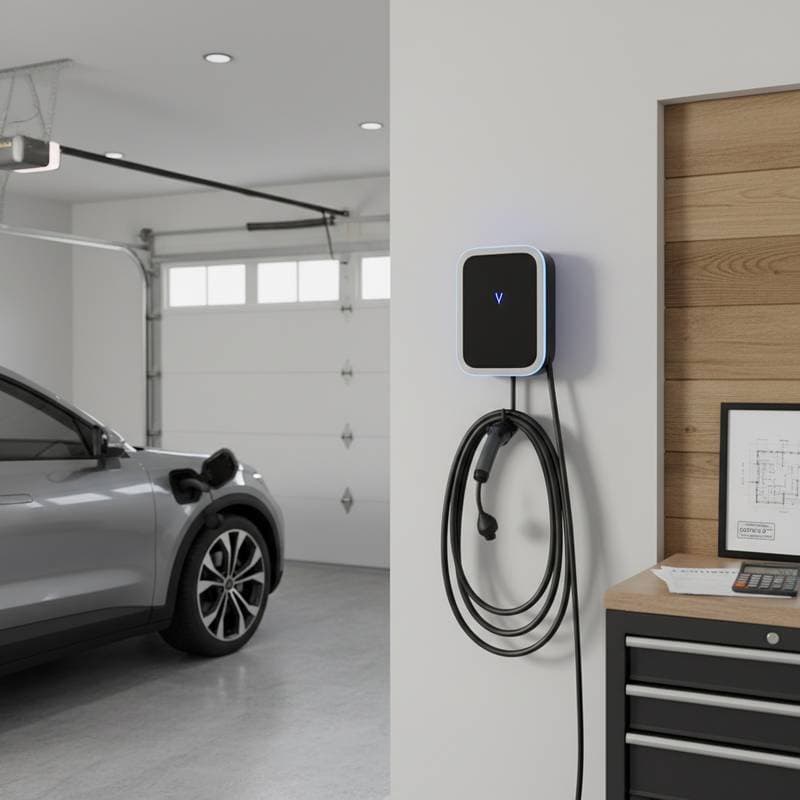Increase Home Value by 14% with an EV Charger Installation
Homeowners who install an electric vehicle charger often see their property value rise by up to 14%. In today's market, prospective buyers prioritize homes equipped for electric vehicles, making this upgrade a key differentiator. This enhancement proves particularly valuable for individuals planning to remain in their residence for several years, those who own electric cars, or anyone aiming to gain an advantage in a crowded real estate landscape.
Installation Cost Overview
National average cost: $800 to $2,500
Standard range for typical homes: $1,200 to $1,800
Variations: $400 for a simple plug-in model; up to $4,000 for advanced smart chargers requiring electrical panel enhancements
Several factors influence the total expense.
- Charger category, such as Level 1, Level 2, or intelligent models
- Length of wiring from the electrical panel to the parking area
- Existing panel capacity and potential need for subpanels or service expansions
- Mounting style, whether wall-mounted or pedestal-based
- Fees for local permits and inspections
Advantages and Drawbacks
Advantages
- Enhances resale attractiveness and overall property worth
- Significantly shortens charging duration over standard Level 1 outlets
- Minimizes dependence on public charging infrastructure
- Accesses available rebates or tax incentives in qualifying regions
- Prepares for upcoming electric vehicle acquisitions
Drawbacks
- Involves initial electrical modifications
- May necessitate panel upgrades due to insufficient capacity
- Introduces slight additional energy expenses
- Intelligent models risk connectivity issues or require software updates
- Exterior placements demand protective weatherproofing
Charger Varieties and Selections
Level 1 Charger
This option utilizes a conventional 120-volt outlet. It provides gradual charging, yielding approximately 3 to 5 miles of driving range per hour. Such chargers suit owners of plug-in hybrids or drivers with minimal daily mileage.
Level 2 Charger
Operated on a 240-volt circuit, this type delivers 20 to 30 miles of range per hour. Homeowners with regular commuting needs find it the most practical choice.
Smart Charger
These connect via Wi-Fi or Bluetooth for features like scheduling, usage monitoring, and remote control through a mobile application. They enable optimization of charging during off-peak electricity hours to reduce costs.
Dual-Port Charger
Designed to charge two vehicles simultaneously, this variant benefits households with multiple electric vehicles or communal garage setups.
Portable Charger
A compact, plug-in device that relocates easily. Although slower than fixed installations, it offers versatility, especially for tenants.
Handling Installation: DIY or Professional
DIY Complexity: Moderate to advanced
Estimated Time: 2 to 6 hours, based on wiring extent
Required Tools: Wire cutters, conduit benders, voltage testers, drills, and protective equipment
Potential Hazards: Risk of electrical shock, regulatory non-compliance, or fire hazards from improper wiring
Engage a licensed electrician in these scenarios:
- When the electrical panel has no available breaker slots
- For wiring runs exceeding 25 feet
- If local regulations mandate permits
- For hardwired setups or outdoor placements
Professionals guarantee adherence to building codes, appropriate amperage settings, and secure grounding practices. The investment in expert labor typically recoups through elevated property value and enhanced safety.
Essential Installation Steps
- Assess Panel Capacity. Verify available amperage and open breaker positions.
- Choose Charger Type. Select based on vehicle specifications and usage patterns.
- Secure Permits. Contact local authorities, as electrical permits and inspections are frequently required.
- Determine Placement. Identify a location proximate to the vehicle parking with sufficient cable extension.
- Route Wiring. Install conduit and cabling from the panel to the mounting site.
- Affix the Charger. Attach securely to a wall or pedestal following the manufacturer's guidelines.
- Wire the Circuit. Connect the breaker and validate voltage levels.
- Conduct Inspection and Activation. Arrange for official review if needed, then verify charging operation.
- Finalize Setup. Label the circuit, file away manuals, and clear any debris.
Image: A licensed electrician securing a Level 2 wall-mounted charger within a home garage.
Upkeep and Durability
Home EV chargers generally endure 8 to 12 years with proper care. Regularly clean connectors and prevent cable tangles. Perform biannual checks on cords and plugs for signs of deterioration. For smart models, apply firmware updates via their applications as released. During yearly electrical reviews, ensure breaker connections remain firm. Protect outdoor units with appropriate covers and examine seals for damage.
Manufacturers often provide warranties spanning 3 to 5 years. Compliance with UL standards or the National Electrical Code ensures ongoing safety in many jurisdictions.
Alternative Charging Solutions
Public Station Utilization
Access complimentary or fee-based chargers at workplaces or retail sites. This approach avoids installation expenses but sacrifices daily convenience.
Portable 240-Volt Adapter
Connects to existing outlets for basic charging. It presents a budget-friendly option, though speeds lag behind dedicated systems.
Solar-Integrated Charging
Combines with residential solar panels for reduced energy consumption over time. Initial costs exceed standard setups, yet long-term savings appeal to sustainability advocates.
Community Shared Stations
Positioned in collective parking zones, these serve condominiums or associations through coordinated efforts with homeowners' groups.
Regional Considerations
Costs fluctuate by geographic area. Coastal properties might require enclosures resistant to corrosion. In colder regions, charging efficiency decreases, often necessitating insulated wiring. Older residences with panels under 150 amps commonly demand capacity expansions.
Municipalities with rigorous codes or elevated permit charges can increase expenses by $150 to $500. Certain utilities provide incentives like rebates or discounted rates for nighttime usage. Verify all regional stipulations prior to contracting services.
Return on Investment and Market Impact
In communities with substantial EV prevalence, a functional charger can boost home value between 10% and 14%. Buyers perceive it as an immediate, desirable feature, akin to upgraded insulation or renewable energy systems.
Properties advertised with EV readiness attract environmentally aware purchasers and move more quickly. The financial return hinges on local market dynamics, EV adoption rates, and charger sophistication. Advanced smart systems on 240-volt circuits yield the highest appreciation.
Safety Protocols
High-amperage wiring defines EV charger setups. Deactivate power at the main breaker prior to any handling. Employ conduit suitable for damp or exposed environments. Ground metallic enclosures and adhere to National Electrical Code specifications for wire gauge and breaker sizing. Prohibit the use of extension cords with Level 2 chargers.
Position outdoor units at least 18 inches above ground level to avoid moisture exposure. Refrain from altering original wiring or severing charger cables. Consult professionals for connections to the primary service or complex load assessments.
Frequently Asked Questions
How much electricity does a home EV charger consume?
Level 2 models typically draw 16 to 50 amps, depending on the unit. A standard session utilizes about 6 to 12 kilowatt-hours.
Is a dedicated circuit necessary?
Yes, each charger requires its own circuit equipped with an appropriately rated breaker.
Can a charger be installed in a carport?
Affirmative, provided the equipment carries outdoor ratings, along with weather-resistant conduit and ground fault circuit interrupter protection.
Does installation affect homeowners insurance?
Certain providers may seek documentation of professional work, but coverage terms generally stay unchanged.
What if relocation is imminent?
Opt for a portable model, which you can relocate, while still promoting the property as EV-compatible.
Execute Your EV Charger Project
Prepare thoroughly before purchasing. Inspect your electrical panel, evaluate charger specifications, and solicit estimates from at least two licensed electricians. Inquire about applicable incentives and permit processes. A meticulously executed, compliant installation not only amplifies property worth but also promotes eco-friendly living and streamlines routine charging. Post-installation, document the circuit labeling and retain records for prospective buyers.









